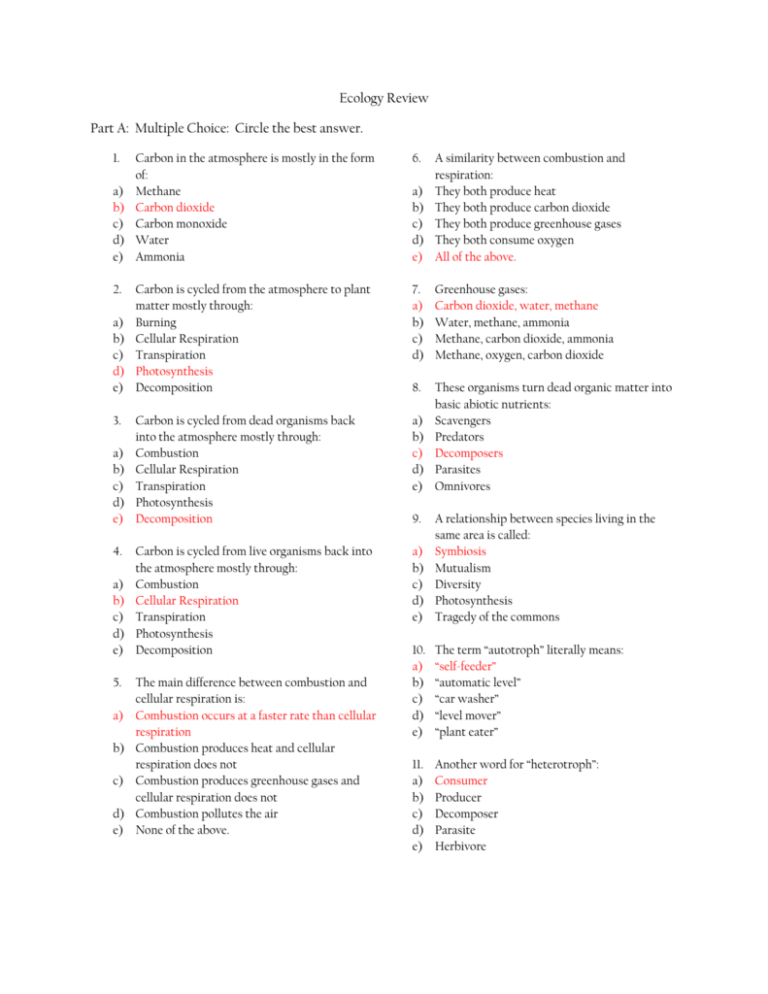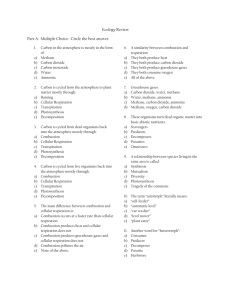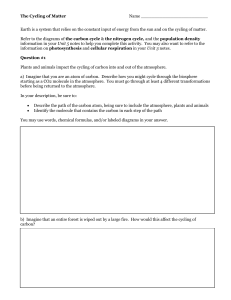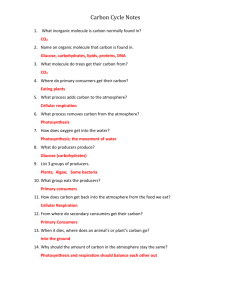Eco Review Quiz Answers - hhs
advertisement

Ecology Review Part A: Multiple Choice: Circle the best answer. 1. a) b) c) d) e) 2. a) b) c) d) e) 3. a) b) c) d) e) 4. a) b) c) d) e) 5. a) b) c) d) e) Carbon in the atmosphere is mostly in the form of: Methane Carbon dioxide Carbon monoxide Water Ammonia 6. a) b) c) d) e) A similarity between combustion and respiration: They both produce heat They both produce carbon dioxide They both produce greenhouse gases They both consume oxygen All of the above. Carbon is cycled from the atmosphere to plant matter mostly through: Burning Cellular Respiration Transpiration Photosynthesis Decomposition 7. a) b) c) d) Greenhouse gases: Carbon dioxide, water, methane Water, methane, ammonia Methane, carbon dioxide, ammonia Methane, oxygen, carbon dioxide 8. Carbon is cycled from dead organisms back into the atmosphere mostly through: Combustion Cellular Respiration Transpiration Photosynthesis Decomposition a) b) c) d) e) These organisms turn dead organic matter into basic abiotic nutrients: Scavengers Predators Decomposers Parasites Omnivores Carbon is cycled from live organisms back into the atmosphere mostly through: Combustion Cellular Respiration Transpiration Photosynthesis Decomposition a) b) c) d) e) A relationship between species living in the same area is called: Symbiosis Mutualism Diversity Photosynthesis Tragedy of the commons 10. a) b) c) d) e) The term “autotroph” literally means: “self-feeder” “automatic level” “car washer” “level mover” “plant eater” 11. a) b) c) d) e) Another word for “heterotroph”: Consumer Producer Decomposer Parasite Herbivore The main difference between combustion and cellular respiration is: Combustion occurs at a faster rate than cellular respiration Combustion produces heat and cellular respiration does not Combustion produces greenhouse gases and cellular respiration does not Combustion pollutes the air None of the above. 9. 12. a) b) c) d) e) This material is rich in nitrogen: Methane Carbon dioxide Water The lithosphere Manure 13. a) b) c) d) e) The chemical symbol for ammonia is: CH4 CO2 H2O NH4 C6H12O6 14. This process requires carbon dioxide and water and produces oxygen a) Photosynthesis b) Cellular respiration c) Combustion d) Farting e) Peeing 15. a) b) c) d) e) At the bottom of a food chain, web or pyramid: Producers Primary consumers Secondary Consumers Top predators Parasites 16. a) b) c) d) e) Three examples of biomes: Scavengers, predators, decomposers Grasslands, aquatic, desert Pond, river, lake Lithosphere, atmosphere, hydrosphere None of the above 17. a) b) c) d) e) Another word for non-native: Invasive Exotic Indigenous Parasitic Autotrophic 18. a) b) c) d) e) Not a decomposer: worm vulture bacteria fungus millipede 19. A _________________ consumes primarily animals that are recently killed by another species: a) decomposer b) scavenger c) parasite d) herbivore e) consumer 20. Cows add to the greenhouse effect most strongly by: a) Producing manure b) Eating grass c) Farting d) Breathing oxygen e) Respiration 21. Certain birds clean the ears of water buffalo by eating fleas that nest in the ear. This is an example of: a) Predation b) Commensalism c) Mutualism d) Competition e) Bilingualism 22. a) b) c) d) e) Put in order from smallest grouping to largest: Ecosystem, biome, community, population Biome, ecosystem, community, population Community, population, ecosystem, biome Population, community, ecosystem, biome Community, ecosystem, population, biome 23. This organism belongs to more than one trophic level: a) Dandelion b) Rabbit c) Cow d) Human e) None of the above 24. A robin eats insects and worms and builds nests in trees using bits of fallen branches and loose grass. It can be preyed on by cats. This describes the robin’s : a) Niche b) Habitat c) Community d) Population e) Gender 25. In a dense jungle, taller trees get the most sunlight. This is an example of: a) Mutualism b) Commensalism c) Predation d) Parasitism e) Competition 28. a) b) c) d) e) Which of the following is TRUE? All invading species are introduced All introduced species are invasive All introduced species are native All native species are exotic None of the above. 26. Examples of abiotic limiting factors: a) Food availability, water availability, climate b) sunlight availability, water availability, temperature c) number of predators, oxygen level, climate d) living space, food availability, availability of mates e) none of the above 29. A pond can support a dozen or so turtles before it begins to get too crowded. Any more than this and the food supply will start to become scarce. This is an example of: a) Carrying capacity b) The greenhouse effect c) An engineered ecosystem d) The tragedy of the commons e) Biodiversity 27. Which of the following is TRUE? Introduced species are: a) all brought on purpose from another land b) all invasive in their new land c) all non-native d) never able to adapt to the new environment e) always top of the food chain. 30. In a food web: a) Producers are at the bottom b) Arrows indicate the direction of feeding (i.e. from food to consumer) c) Some organisms have multiple arrows d) Energy is lost from one trophic level to another e) All of the above Long Answer Questions: 1. Explain the difference between a law, a theory and a hypothesis. Law: A statement that generalizes observations on a certain subject. Examples: “what goes up must come down.” “Cars must stop at red lights.” Theory: An accepted explanation for a certain phenomenon. Theories are tested and can change to reflect any new information. Scientific theories are generally well tested and have not been modified in a long time. Examples: theory of gravity, the theory of evolution, the Big Bang theory. Hypothesis: An educated guess of what will happen during an experiment. Unlike a theory, a hypothesis has not been tested yet, but will be through experiment. 2. What is the origin of all energy on Earth? The sun is the source of most of the energy on Earth. The Earth itself has some energy in the form of heat in its core (geothermal energy) and rotational energy (because it is spinning). But 99.9% of all life gets its energy directly (plants) and indirectly(consumers) from the sun. 3. What is a biome? A biome is a region with a distinct climate and ecology. The aquatic biome and the desert biome, for example. In one, you have lots of water, aquatic animals and plants, a little sunlight and cool temperatures. In the other you have little water, plants and animals adapted to the hot and dry conditions, and hot temperatures. Other examples of biomes are forest (tropical, deciduous, boreal), grasslands (savannah) etc. 4. Explain the greenhouse effect. This is the effect when certain gases in the atmosphere reflect heat back down onto the Earth. Rays from the sun heat up the Earth’s surface. Most of these rays reflect off the Earth and head out into space. Gases like CO 2 , H2O and CH4 reflect some of this heat back down and do not let it escape. When this happens, the Earth warms up, like a greenhouse (a greenhouse is a small house made of clear plastic that traps the sun’s heat. This can be used to plant crops in the winter). The trapping of heat in the atmosphere is called the Greenhouse Effect. 5. Explain why decomposers are so important in the carbon and nitrogen cycle. Without decomposers, the carbon and nitrogen cycle wouldn’t be much of a cycle. Plants get carbon out of the atmosphere by photosynthesis. They get nitrogen directly from the soil and from certain bacteria (nitrogen-fixing bacteria) that take it out of the atmosphere and put it in a form useable by plants. Consumers get carbon and nitrogen by eating plants. The consumers store some of it and excrete some carbon (manure) and nitrogen (urine) back to the soil. The rest is released when they die. Decomposers turn this biotic material back into CO2 and N2 gases where it returns into the atmosphere. Without decomposers, the atmosphere would run out of CO2 and N2, plants would die without CO2 and the Earth would be overflowing with dead corpses, urine and manure. 6. What is the primary difference between a community and an ecosystem? A community is a group of all organisms living in an area. The ecosystem includes the community, but also includes the non-living (abiotic) elements, such as the water, land and air. 7. Draw the carbon cycle. Just Google “carbon cycle” and look at the images. Here are some examples: http://commons.wikimedia.org/wiki/File:Carbon-cycle-full.jpg http://www.frankswebspace.org.uk/ScienceAndMaths/physics/physicsGCSE/carbonCycle.htm The key processes are: Photosynthesis Combustion Respiration Decomposition Diffusion in and out of water The middle three processes (combustion, respiration, decomposition) put CO2 into the atmosphere, increasing the Greenhouse effect. Only the other two (photosynthesis and diffusion from water) take CO2 out of the air. The stores of carbon are: The atmosphere In all living things In sediments at the bottom of the ocean (mostly from shells) In fossil fuels under ground In water and ice (bubbles of CO2) Until recently, the first two stores traded carbon back and forth in a stable cycle. Now the burning of fossil fuels and the melting of the ice cap is releasing much more carbon dioxide into the air than we are able to cycle back. 8. Name 3 carbon sinks. A sink is a store. See answer above for 5 possible answers. 9. Explain why North Americans demand for beef is a direct cause of global warming. Cows produce methane, a greenhouse gas. More methane in the atmosphere means the sun’ s rays are being trapped and reflected back on the Earth, causing the temperature of the Earth to increase. Cows produce CO2 and H2O when they breathe. This is not such a big problem as the methane, since they don’t produce as much and it does not have as much an effect on the greenhouse effect. Cows are produced on large farms which need to have trees removed. Clear-cutting a forest will mean fewer trees for photosynthesis. This means less CO2 is removed from the atmosphere. CO2 is another greenhouse gas, so this produces more global warming. Cows are often farmed in countries far away and then shipped to our grocery. The shipping process burns fossil fuels (fuel for trucks and boats), which in turn produces more CO2. 10. Give an example of a limiting factor that becomes more of a factor with increasing population density. Availability of food, habitat. Living space, disease, predators. 11. Give an example of a limiting factor that becomes more important as population decreases. Availability of mates (for sexual reproduction, for safety, for division of labour). 12. Give an example of a limiting factor that is not affected by population density. Climate, temperature, earthquakes, forest fires. 13. If the rabbit population in a certain area were suddenly rid of predators (wolves, fox, coyote, hawks etc.) what would happen in the short and long term? Short term – rabbit population would go up. Long term – disease, lack of food, cramped living space – rabbit population might stabilize or go down. If there is lots of space and food can be found, population would thrive. 14. Write the equation for photosynthesis as a : a) Word equation carbon dioxide and water + energy (sunlight) oxygen and glucose b) Chemical equation CO2 + H2O + Energy O2 + C6H12O6 c) Balanced chemical equation. 6CO2 + 6H2O + Energy 6O2 + C6H12O6 15. Repeat the previous question for cellular respiration. Same, but in reverse: d) Word equation oxygen and glucose carbon dioxide and water + energy e) Chemical equation O2 + C6H12O6 CO2 + H2O + Energy f) Balanced chemical equation. 6O2 + C6H12O6 6CO2 + 6H2O + Energy 16. Explain the greenhouse effect and global warming. See question #4 17. Why are the carbon cycle and nitrogen cycle important for the survival of our planet? See question #5. If carbon and nitrogen was not recycled, we would run out. When we die, the carbon and nitrogen in our bodies is returned to the atmosphere, so that it can be used again by plants and eventually consumed by other animals. 18. Explain the tragedy of the commons as it applies to a specific environment or ecosystem. The tragedy of the commons is what happens when no one is in charge of a common property. As a specific example, we all breathe air, but no one owns the air we breathe. As a result, we pollute the air in many ways (combustion in cars, factories and homes, cows produce methane, noise pollution in cities etc.). We do this even though we know that it is bad for us! This has negative health effects, but no one is in charge, so it takes a lot of work to get something done about it. 19. Explain why biodiversity is important for an ecosystem to be healthy. Biodiversity is having many different species in an ecosystem. Diseases often target one species. If a disease eliminates or weakens one species in a food web, then other species in that food web will also be affected. If the food available is scarce, then the result can wipe out an entire part of an ecosystem. If the ecosystem is diverse, then most species will be able to find an alternative food source, and will not be so deeply affected. In general, each species will be affected differently by limiting factors, other than disease. For example, if the winter was long one year, that might wipe out a certain kind of grass in an area. If there are many kinds of grass in that area, some will survive and take the place of the grass that did not regenerate in the spring. If there is only one kind of grass in that area, it might take years for the area to regenerate, wiping out many primary and secondary consumers along with it. 20. Explain how bioengineered ecosystems can upset the local ecosystem. Bioengineered (like a farm) ecosystems are designed to have little diversity on purpose. They grow certain crops (like corn) and certain livestock (like sheep or cattle). The problem is, they must be artificially watered (not relying on rain), diverting water from lakes and rivers. Because they are on farms that have few trees, the water does not stay in the soil, but it runs off back into the rivers. The crops are given nutrients to help them survive (like fertilizer for plants and vitamins and hormones for animals). They are given pesticides to protect them from predators and pests. All of these chemicals end up draining into the rivers when it rains. The fertilizer causes plant life in ponds, rivers and lakes to grow out of control, which chokes out and kills the fish. The pesticides and hormones and vitamins end up also getting into our lakes and into our drinking water, making our water unsafe to drink. When we eat the plants and animals, we ingest these chemicals and end up potentially getting sick. Finally, when the chemicals end up being ingested by other organisms, they get bio-amplified up the food chain, so that by the time we consume them, they have become dangerous to us.







